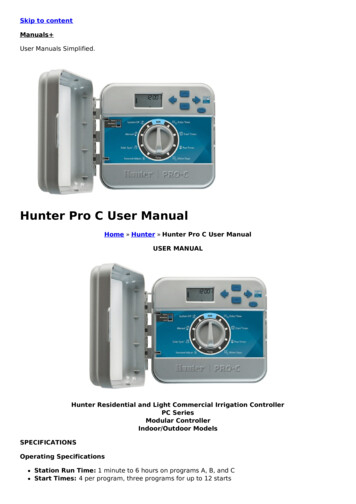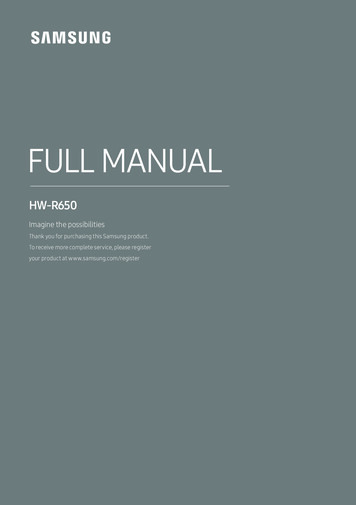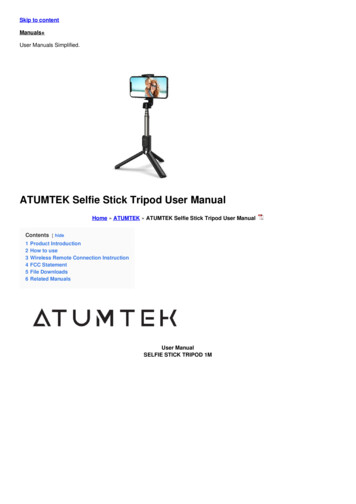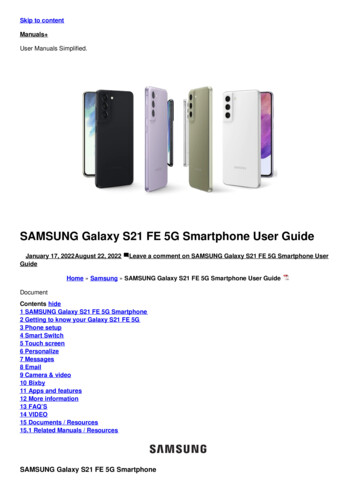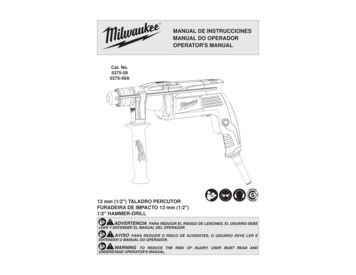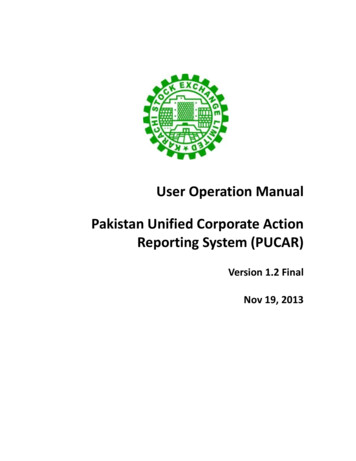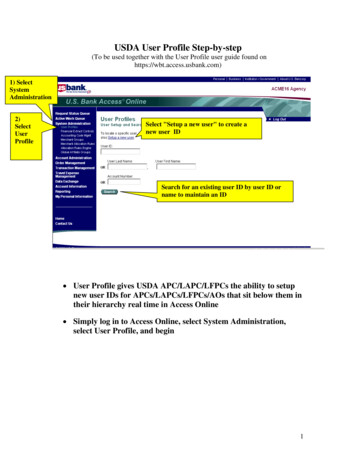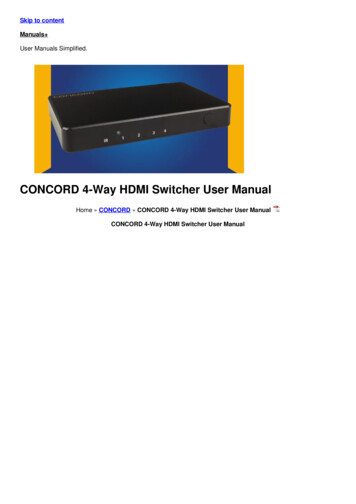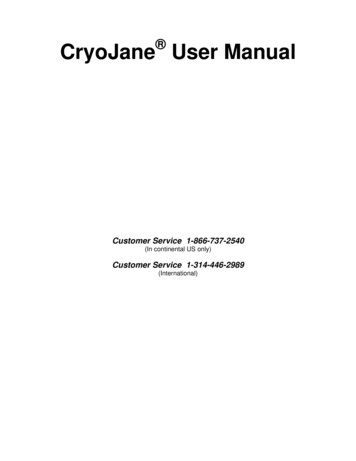
Transcription
CryoJane User ManualCustomer Service 1-866-737-2540(In continental US only)Customer Service 1-314-446-2989(International)
Instrumedics grants the purchaser of the CryoJane systemthe rights to use the patented CryoJane materialsPatent # 5,444,105CRYOJANE TAPE-TRANSFERSTEP-BY-STEP INSTALLATION INSTRUCTIONS2
Absolute AlcoholThe following items are required for installation:Hair DryerGauzeGloves01 Remove release paperfrom ECU02 Place ECU on top leftcorner of cryostat03 Using absolute alcohol and gauzeclean chamber wall04 Heat left wall forMech/Flash Unit & Oil Bathplacement Also heat theexposed adhesive on themounting plate and oil bath05 Place Oil Bath towards therear of the left chamber wall06 Route Oil Bath & Mech/Flash UnitCables underneath Mech*07 Place Mech/Flash Unit inChamber.Place Mech/Flash Unit low inchamber near the front wall.(Placement near the freezebar is ideal in most cryostats)08 Route cables in door bar09 Place door bar with cablesonto front chamber ledge.If required attach Door Bar Support Stripunderneath door bar3
10 Adhere Cable holdersalong cryostat top outer wall11 ECU Rear with Cable &Power Cord Connectors12 Connect Mech/Flash Unit, Oil BathCables to ECU& Power cord to the ECU and wall outletTurn the ECU on13 Mech/Flash Unit Cableconnected to ECU14 External-InstallationCompleteCryo-Vac Shown15 Internal-Installation CompleteCryo-Vac Shown*The standard CryoJane Mech/Flash Unit installation is shown in Fig. 07.The Microm HM 560 cryostat requires an S-Plate Mech and separate mountingplate for installation.S-Plate Mech/Flash Unit for the Microm HM 560 CryostatMounting Plate locks onto S-Plate Mech/Flash UnitSlide Nest EntranceThe entire assembly is adhered to the left cryostat wall as shown in Fig. 07.Note:The S-Plate Mech/Flash Unit must have enough clearance from the frontwall of the cryostat for slides to enter the Slide Nest.4
Table of ContentsInstrumedics Frozen Section Process Overview 7Freezing Process . 7CryoJane Process 7CryoJane System Components .8CryoJane ECU .9CryoJane Mech/Flash Unit Components .10CryoJane Operating Procedure 11Background . 11Preparation . 11Use . 12Steps for a Single Section 12Steps for Multiple Sections . 18Summary of the Instrumedics Frozen Sectioning Process .19Special Fixation 20Aqueous Fixation . 20“Anhydrous” Fixation . 21CryoJane Maintenance .22ECU 22Mech/Flash Unit 522
Troubleshooting Guide 23Troubleshooting the Mech/Flash Unit and ECU 23CryoJane Process Troubleshooting . 25Troubleshooting Finished Slides . 27Oil Bath Accessories Kit Components .29Oil Bath Accessory Kit Operating Procedure .30Background 30Preparation . 30Use Storing a Tissue Block .Sectioning a Stored Tissue Block .Oil Bath Accessory Kit Troubleshooting Guide .631313132
Instrumedics Frozen Section Process OverviewFreezing Process - Conventional Freezing vs. Snap FreezingIn the conventional freezing method, the tissue is typically frozen at about -30 C. Duringthis relatively slow freezing process, the ice crystals that form are usually large comparedto cellular dimensions. These crystals can cause considerable displacement and structuraldamage to the tissue.The Gentle Jane device is designed to snap-freeze the tissue in approximately 8 - 10seconds. The freezing agent can be liquid nitrogen, LN2 chilled isopentane, dry ice or athermoelectric cooler (Peltier device). The temperature at which the tissue is frozenshould be - 60 C or colder.NOTE: Gentle Jane Snap-Freezing methods are described in a separate SnapFreezing User Manual.CryoJane ProcessThe CryoJane process is built around three special methodologies:1. The capture of an undistorted, thin, snap-frozen section on a special cold adhesivetape.2. The lamination of the captured section onto a cold glass microscope slide coated withan ultraviolet light curable pressure sensitive adhesive.3. The curing of the adhesive on the slide with an 8 millisecond ultraviolet flash, and thesubsequent removal of the adhesive tape, leaving a still frozen section firmly adheredto the microscope slide.The CryoJane system is designed to permit the facile application of these methodologies,and can be adapted to virtually all model cryostats.7
CryoJane System ComponentsFIGURE 1. CryoJane System Components1. Mechanism/Flash Unit. See CRYOJANE MECH/FLASH UNITCOMPONENTS for details.2. Electronics Control Unit (ECU). See CRYOJANE ECU for details.3. ½ inch diameter Mech/Flash UnitCable (connected to the Mech)4. Door Channel5. 2-Shelf Unit6. Hand Roller7. Adhesive Coated Slides8. Tape Windows9. Knife Facet Wipers10. AC Power Cord (not shown)OPTIONAL EQUIPMENT:11. Protective Oil Accessories Kit(see Oil Bath Accessories Kit sections in this manual)12. Cryo-Vac-Away System(see Cryo-Vac-Away User Manual)CryoJane ECU8
1524367Figure 3. CryoJane ECU - front and left sideFigure 2. CryoJane ECU - back1. On/Off Switch2. Pad LED3. Power LED (or Bath LED if optional Oil Bath Accessory Kit is installed).4. Flash/Pad Connector5. Optional Oil Bath Connector6. Fuses7. AC Power Cord ConnectorCryoJane Mech/Flash Unit Components9
FIGURE 4. CryoJane Mech Components1. Blue/Gray Pad2. Stainless Steel Spring Clip3. Black Knob4. Flash Tray5. LidCryoJane Operating Procedure10
BackgroundIn conventional sectioning the operator usually guides the cut section over the knife usinga brush or an anti-roll device. Even with a skillful, steady hand, this step can be difficult,especially if a 2 to 4 micron thick section is desired.To mount the section, a room-temperature slide is touched to it. When contact is madebetween the warm slide and the frozen section, instantaneous melting of the sectionoccurs, converting the ice crystals back into water. Surface tension causes the meltedsection to adhere to the slide. When the ice melts, water fills the spaces formerlyoccupied by the ice crystals, rehydrating the nucleoplasm and cytoplasm, causingerythrocytes to lyse and soluble substances to be displaced. Flow of the melted solutionscan distort and displace fine structure. Often the melted section is then dried, duringwhich step, surface tension forces further distort, displace and collapse tissue structure.Pathologists and clinicians have been trained to recognize normal and abnormal structureagainst this background of degraded fine structure.In contrast, the CryoJane process is designed specifically to avoid melting and air dryingand its associated artifacts. It uses a cold adhesive tape to support and capture the sectionduring the cutting step. The unthawed section on the tape is then transferred to a specialcold adhesive-coated slide. The section is not melted in the mounting step. The adhesivecoating on the slide is then polymerized, and the tape is peeled away, leaving the sectionpermanently anchored to the slide while still frozen.Preparation A day’s supply of Adhesive Coated Slides and Tape Windows should be in thecryostat, chilled and ready for use.The cryostat temperature should be -25 C to -30 C (depending on the cryostatmodel).The Pad light (left LED) on the ECU should be green.The right LED should be red if it is labeled Power and green if it is labeled Oil Bath.UseOnce a tissue specimen has been frozen and mounted in the microtome chuck, follow theprocedure outlined below.11
Steps for a Single Section:1. If the Cryo-Vac-Away is installed,position the collection nozzle at theknife edge and step on the foot switchto automatically remove debris duringthe trimming sequence. If the CryoNozzleVac-Away is not installed, trim theblock to the desired depth to obtain afull block face and remove the debrisfrom the knife. Set the micrometer forthe desired section thickness and cuttwo or three sections to be sure a fullFigure 5. Block trimming and debris removal.section will be cut.2. Take a pre-cooled, pouched, AdhesiveCoated Slide, and while holding itinside the cryostat chamber, removethe glass slide from the pouch.Figure 6. Adhesive coated slide in pouch.3. Holding the Slide at the frosted end,rapidly peel off the protective mylarfilm which covers the adhesive anddiscard it.Figure 7. Peeling mylar from adhesive coatedslide.12
4. Place the Coated Slide, adhesive-sideup, on the Blue/Gray Pad of the Mechby slipping the frosted end of the slideunder the stainless steel Spring Clip.Figure 8. Adhesive Coated Slide on Blue/GrayPad.5. Inside the cryostat, pick up a pinkTape and peel away the protectivefilm covering the adhesive window.Discard the protective film.Figure 9. Exposing the Tape window.6. Hold the Tape up by the narrow tabwith the adhesive side towards theblock face. Position the Tape in frontof the trimmed block so that thebottom edge of the exposed adhesiveis aligned with the bottom edge of theblock. Place the Tape on the blockface making sure that the bottomwider tab of the Tape overhangs theknife. NO PORTION OF THEADHESIVE WINDOW SHOULDOVERHANG THE BLOCK FACE.TO AVOID MELTING THESURFACE OF THE TISSUE DONOT TOUCH THE PORTION OFTHE TAPE THAT COVERS THEBLOCK FACE.Figure 10. Placing Tape on block face.13
7. Using the cold Hand Roller, laminatethe Tape to the face of the block bymoving the Roller up and down one totwo times and then left to right one totwo times. Some pressure is requiredfor good adhesion. When finished,place the Hand Roller back to itsoriginal position inside the cryostat.Figure 11. Laminating the Tape to the block face.8. Turn the flywheel slowly and evenlyto cut a section. If a sharp knife isused, the section captured on the Tapewill be flat, intact, uncompressed andcan be as thin as two microns. Noneed for a brush or an anti-rolldevice!Figure 12. Cutting the section.14
9. Pick up the Tape at either tab andtransfer it to the Slide on theBlue/Gray Pad making sure to keep itdown inside the cryostat to avoidmelting the section.Figure 13. Handling the cut section.10. Position the Tape, section-side-down,on the Adhesive Coated Slide. Formultiple sections refer to the Steps forMultiple Sections.Figure 14. Positioning the Tape on the Slide.11. Use the cold Hand Roller to laminatethe Tape to the Slide. Apply evenpressure on the Roller and roll it overthe section under the Tape two orthree timesFigure 15. Laminating the section to the Slide.15
12. Holding the frosted end of the Slide,remove it from the Blue/ Gray Padand transfer it into the Flash Tray.Gently push the Slide in as far as itwill go, against the stop. (To check,lift the Lid.) Close before actuatingthe flash.Figure 16. Placing the slide into the Flash Tray.13. Push and release the Black Knob toactuate the UV flash. The UV curesthe adhesive on the Slide into apolymer, anchoring the frozen sectionto the Slide.DO NOT FLASH MORE THATONCE EVERY 30 SECONDS.MORE OFTEN CAN SERIOUSLYDAMAGE THE ECU.Figure 17. Curing the adhesive on the Slide.14. Holding the frosted end, immediatelyremove the cured Slide from the FlashTray. DO NOT TAKE THE SLIDEOUT OF THE CRYOSTAT AT THISTIME AS THAT WILL CAUSE THESECTION TO MELT.Figure 18. Removing the cured Slide.16
15. Keeping the Slide deep inside thecryostat chamber, carefully removethe pink Tape to expose thetransferred frozen section on the Slide.Figure 19. Removing Tape from cured Slide.16. Peel off the Tape diagonally anddownward to minimize sheer stress onthe section and to insure completetransfer. Do not touch the sectionwith your fingers. Once removed,discard the Tape.The slide can now be:a) fixed in the Instrumedics AqueousFixative,b) freeze-dried or freeze-substituted inthe cryostat before “anhydrous”fixation,c) melted or air-dried and fixed withthe fixative of choice for yourprotocolFigure 20. Technique for removing Tape fromSlide.Note:The section should beimmersed in the room temperaturefixative inside the cryostat. Fixationshould then continue at roomtemperature.17
Steps for Multiple Sections:17. Multiple sections can be positioned onone Slide by placing the Tapesperpendicular to the Slide. For smalltissue specimens, the Tape can be cutinto narrower strips. Follow Steps 5 - 9.18. To cure the adhesive on the slide, liftthe Lid of the Mech and seat the Slideon the Flash Tray. The Tape tabs willoverhang the Flash Tray.Figure 21. Processing multiple sections.19. Close the Lid and push and release theBlack Knob to actuate the UV flash.Then lift the Lid, remove the Slide andcarefully peel away each strip of Tapeas described in Steps 15 and 16.Figure 22. Curing multiple sections.18
Summary of the Instrumedics Frozen Sectioning ProcessSnap-freezing and embedding.A blockholder is placed on the Gentle Jane snap-freezing device.CryoGel or other embedding media is dispensed onto the blockholderand a tissue specimen is positioned on top. The chilled heat extractor isplaced in its holder and released. When the heat extractor contacts thespecimen, the tissue and embedding medium is snap-frozen into a flatblock. The plane of the flat block face minimizes trimming. Whenspecimen shape or orientation are essential, the tissue is snap-frozenusing the Instrumedics CryoGel / Rubber Mold method.FIGURE 23. To minimize ice-crystalsize, tissue is snap-frozen with a chilledheat extractor.CuttingAfter the block is trimmed, a cold adhesive tape is adhered to the blockface. The tape supports and captures the section as it is being cut,eliminating the need for a brush or anti-roll device.FIGURE 24. A cold adhesive tape isused to support the section as it is beingcut.Transfer to SlideA cold adhesive-coated slide is placed on a temperature-controlled pad.The adhesive tape is placed section-side-down on the adhesive-coatedslide, and is laminated to the adhesive layer using a cold roller.FIGURE 25. The still frozen section,adhered to the tape is rolled onto thecold adhesive-coated slide.Curing the Adhesive CoatingFIGURE 26.An ultraviolet flashconverts the adhesive coating into a hardsolvent-resistant plastic.A flash of ultraviolet light passes through the slide to polymerize theadhesive layer on the slide into a hard, solvent-resistant plastic, tightlyanchoring the section. to the slide.Removal of TapeFIGURE 27. The tape is removed.Several options are availableThe tape is peeled away leaving the still frozen section tightly bonded tothe plastic layer.The slide can then be:a) fixed in the Instrumedics Aqueous Fixative,b) freeze-dried or freeze-substituted in the cryostat before “anhydrous”fixation,c) melted or air-dried and fixed with the fixative of your choice.19
Special Fixation ProtocolsAqueous Fixative: THIS FIXATION SHOULD BE USED FOR ALLHISTOLOGICAL STAINING OF CRYOJANE PREPARED SECTIONS.This fixative melts and fixes the tissue simultaneously (direct controlled “melting”). Icecrystal artifacts (holes) are masked. Nuclear morphology is usually excellent. Some cellcomponents are lost and most of the red blood cells are lysed.1. PREPARATION OF AQUEOUS BUFFERDissolve Buffer-Salt Mix in 180 ml of water.Buffer-Salt Mix is available from Instrumedics (Cat. #AB)Store in refrigerator. Usable for at least 6 months.2. PREPARATION OF AQUEOUS FIXATIVEAdd 20 ml of 25% glutaraldehyde to 30 ml of Aqueous Buffer.Mix well.Use at room temperature.Discard after 1 week. (If using 50% glut. add 10 ml glut. and 10 ml water.)CAUTION! Contains Cacodylic Acid. Avoid contact with fingers or skin.Do not breathe dust from vial.3. PROCEDUREa) After the adhesive coating on slide has been polymerized, carefully peel offthe pink Tape.b) To avoid uncontrolled melting and/or drying of the section, immediately bringthe room temperature aqueous fixative into the cryostat and immerse the slideinto the fixative. Dip 2-3 times.c) Continue to fix for 15 to 30 seconds at room temperature.d) Rinse the slide in water and proceed with a chosen staining protocol.20
“Anhydrous” Fixation Protocol - To be used after “freeze-substitution” in a cold solventsuch as acetone at -30 C or colder.“Anhydrous” fixation preserves most cellular components and is highly recommended forroutine stains. Note: Not recommended when ice crystal size is large and widespread(poor freezing). In such cases the aqueous fixative protocol should be followed. An“anhydrous” fixative contains a maximum of 30% water.1. AN/DMF/GlutDimethylformamide (DMF)Acetonitrile (AN)glutaraldehydeAdd H2O to make up toWait at least 1 our before use.2. Formal-EthanolEthanol (100% alc.)Formaldehyde35 ml35 ml (can use 70 ml DMF and no AN)10 ml 25% Glut (5 ml 50% Glut)100 ml86 ml14 mlBring the fixative into the cryostat and transfer the freeze-substituted slide directly fromthe acetone bath into the fixative. Continue fixation at room temperature for 15 to 30seconds. (Transfer is made within the cryostat to prevent condensation of water on thecold slide prior to fixation.)3. For very sensitive antigens: Fix in the cold for 1 min.DMF/GlutDimethylformamide70 ml25% Glutaraldehyde1 ml100 mlAdd H2O to make up toTransfer the freeze-substituted slide directly from acetone to the fixative at-4 C for 30 to 60 seconds. This transfer must be made within the cryostat.Following fixation, the slides are rinsed in water prior to IHC protocolsREFER TO REAGENT MSDS FOR SAFE HANDLING21
CryoJane MaintenanceECU NOTHING SHOULD BE PLACED OR STORED ON TOP OF THE ECU! Anyspills which enter the ECU may severely damage the electronic components. To clean the ECU, wipe the surfaces with either a dry rag, or if necessary, an alcoholwipe. ACETONE OR OTHER SOLVENTS WILL DAMAGE THE PLASTICSURFACES. Fuses can be replaced by unscrewing the two small fuse holders in the rear of theECU. Fuses should be 0.75 AMP SLO-BLO , (available from Instrumedics).DO NOT OPEN THE ECU! Only personnel authorized by Instrumedics shouldservice the ECU. Unauthorized opening of the ECU can cause serious injury and willvoid all warranties. Unauthorized persons will assume all risks and responsibilities.Mech/Flash Unit All metal surfaces may be wiped with alcohol or chlorine solution. The Flash Tray should periodically be cleaned with alcohol to remove any adhesivebuild-up. Care must be taken to avoid damaging the glass filter in the Flash Tray. Liquid spills on the Mech/FlashUnit should be wiped immediately. Electroniccomponents in the Flash Lamp may short circuit if exposed to liquids. DO NOT IMMERSE THE MECH/FLASH UNIT IN ANY SOLUTIONS. To remove the Mech/Flash Unit from the wall for decontamination or servicing,simply unscrew the two screws shown below and then remove the Mech from thecryostat. The Mech/FlashUnit’s mounting plate will remain attached to the wall ofthe cryostat. (Tip: To avoid losing the two screws, screw them into the holes in themounting plate remaining on the wall, attach it to the mounting plate with the twoscrews.22
Troubleshooting the Mech and ECU The LEDs (lights) on the ECU are not on.CauseSolutionMake sure the ECU is properly connected to anelectrical source. Make sure the On/Off SwitchThe ECU is not turned on.on the ECU is in the On position (pushed in).If the LEDs are on that indicates that the ECUhas power.Check the fuses on the back of the ECU andOne or both fuses in the back of the ECU are replace as needed. Use only 0.75 AMP, SLOblown.BLO fuses (available from Instrumedics).Call Instrumedics’ customer service numberThe ECU is malfunctioning.and arrange for servicing of the ECU. DO NOTOPEN THE ECU! The left LED (labeled Pad) always displays a solid red light.CauseSolutionThe ½ inch diameter Flash/Pad Power Cable is Make sure the Flash/Pad Power Cable isnot connected properly.properly connected to the ECU and to the BluePad connector underneath the Mech.The temperature of the Blue/Gray Pad is too Raise the cryostat temperature.cold.Call Instrumedics’ customer service numberThe ECU is malfunctioning.and arrange for servicing of the ECU. DO NOTOPEN THE ECU! The left LED (labeled Pad) always displays a flashing red light.CauseSolutionThe temperature of the Blue/Gray Pad is too Lower the cryostat temperature.warm.If the sections are not melting on the pad ignorethe flashing red lightCall Instrumedics’ customer service. IDO NOT REMOVE THE LID OF ECU!THE ECU LID SHOULD ONLY BEThe ECU is malfunctioning.23
REMOVED BY AUTHORIZED PERSONSONLY IF THE OIL BATH OPTION IS INSTALLED: The right LED (labeled Oil Bath) is always red.Refer to the Oil Bath Accessory Kit Troubleshooting Guide in this manual. The Flash does not go on when triggered.CauseSolutionMake sure the ECU is properly connected to anelectrical source. Make sure the On/Off SwitchThe ECU is not turned on.on the ECU is in the On position (pushed in). Ifthe LED’s on the front of the ECU are on, thatindicates that the ECU is on.The ½ inch diameter Flash/Pad Power Cable is Make sure the Flash/Pad Power Cable isnot connected properly.properly connected to the matching connectoron the rear of the ECU.Check the fuses on the back of the ECU andThe fuses may be blownreplace as needed. NOTE: If flash unit istriggered more than 2 times in one minute, oneOne or both fuses in the back of the ECU are or both fuses on the back of the ECU will blowout and will need to be replaced. This is ablown.protective feature designed to preventoverheating. Use only 0.75 AMP, SLO-BLO,Ceramic Core Wound fuses (available fromInstrumedics).Check for ice build-up around the Black Knobon the Mech and remove if found. If thisThe Flash triggering mechanism is jammed.problem cannot be corrected, call Instrumedics’customer service number and arrange forservicing of the triggeringCall Instrumedics’ customer service number andThe flash unit is malfunctioning.arrange for servicing of the flash unit. DONOT OPEN THE FLASH UNIT!Call Instrumedics’ customer service number andThe ECU is malfunctioning.arrange for servicing of the ECU.DO NOT OPEN THE ECU24
CryoJane Process TroubleshootingThe CryoJane process will not produce the desired results if the cryostat and/or themicrotome are malfunctioning. Both need to be serviced periodically. Check with themanufacturer/dealer. The Tape does not adhere to the block face.CauseSolutionThe protective film covering the adhesive is not Peel away the protective film covering theremoved.adhesive window which says “PEEL THISAWAY”Check the temperature of the cryostat andThe block is too cold or too warm.adjust if necessary. Chamber temperatureshould generally be set between -25 C to -27 Cdepending on the particular cryostat model.There is moisture on the adhesive layer of the Check to see if the cryostat needs to betape or on the blockfacedefrosted. In warm, humid weather keep theThe tape will not adhere to the blockface if cryostat lid closed as much as possiblethere is condensation on either the tape or the The tape will not adhere to the blockface ifblockface.there is condensation on either the tape or theblockface. The Tape does not capture the section.CauseSolutionThe microtome is not advancing.The microtome is not advancing at the desiredthickness.The knife angle is too small or too large.Check the microtome and adjust.Check the microtome and adjust. Cut two orthree sections before applying the Tape.Adjust the knife angle between 3 and 5degrees.The Tape is defective.Use another Tape.The Tape does not stay adhered when the The Tape is overhanging the blockface andsection is being cut.snagging on the knife which causes the tape topull away. Cut the tape so that it fits the block.The blockface is not flat.The block should be faced off (trimmed) so thethe blockface is flat. The Tape should beadhered to the entire surface. The Tape is cut during sectioning.CauseSolutionThe block face is not flat.The adhesive on the Tape overhangs the blockand snags on the knife.Cut the Tape so that is fits the blockface.The knife and/or the block are not be properlyAlign and trim the block to obtain a flat face.Position the Tape on the block so that noadhesive is exposed to the knife when cuttingthe section.Check the knife and block for looseness and25
tightened.tighten all screws and clamps as needed. The captured section on the Tape is not intact.CauseSolutionThe most common cause is the section is not Use pressure when you roll over the section tolaminated with enough pressure to get good laminate to the adhesive layer on the slide. Ifadherence to the adhesive layer.you are using CJ-1X slides you may want to tryCJ-4XIf using a disposable blade, shift to a differentThe knife is dull.portion of the blade’s edge or replace the blade.If using a stainless steel or tungsten-carbideknife, sharpen the knife.There is dirt on the TapeUse a fresh, clean and cold Tape.Bubbles form while laminating the Tape to the Apply the Tape “like wallpaper” to the blockblock face.face while laminating with the cold Roller. Ifbubbles are still visible, reapply the Tape.There is vibration in the microtome (thick/thin, Check the knife and block for looseness andchatter, etc.)tighten all screws and clamps as needed. The Transferred Section is not Intact. Parts of the Section Remain on the Tape.CauseSolutionThe section does not transfer intactRemove the Tape slowly and carefully, peelingit diagonally and downward to minimize thetension on the section.The knife is dull.If using a disposable blade, shift to a differentportion of the blade’s edge or replace the blade.If using a stainless steel or tungsten knife,sharpen the knife.The Tape was not well adhered to the adhesive Pressure must be exerted when rolling the tapelayer on the slide in the laminating step.with the section on to the adhesive layer on theslide to insure the section is well adhered. Thisis critical for good transfer.A bubble may have formed when the Tape was Apply the Tape “like wallpaper” to the Slidelaminated to the Slide.while laminating with the cold Roller.26
Troubleshooting Finished Slides The polymerized adhesive picks up excessive red stain after H&E.CauseSolutionEosin may be too acidic or too alcoholic. This Stain a shorter time, or use an aqueous eosin Ymay cause background staining.at pH 5.0 - 5.2. There are chatter marks (“venetian-blind” effect, parallel to knife edge)in the section.CauseSolutionThere is looseness in the systemCheck tightness of chuck. Clamp knife holderand/or blade holder very tightly.If using a disposable blade, shift to a differentportion of the blade’s edge or replace the blade.If using a stainless steel or tungsten knife,sharpen the knife.Cut slowly without stopping. If motor drive isused, set cutting speed slower.The knife is dull.Stop/start motion during cutting. There are tears in the section.CauseSolutionIf using a disposable blade, shift to a differentThe knife has a nick or defect on the cutting portion of the blade’s edge or replace the blade.edge.If using a stainless steel or tungsten knife,sharpen the knife. Small clusters of cells (usually circular) are missing in the section.CauseSolutionBubbles or debris was captured between theadhesive Tape and the block face, or betweenthe Tape and the coated Slide.A hole in the block face may be due to groupsof cells being “plucked-out” during or prior tosectioning.Debris was caught between the Tape and block,or between the Tape and the coated Slide.To avoid bubbles, apply Tape “like wallpaper”.If bubbles are visible under the Tape on theblock face, reapply the Tape. Use clean Tape.This may be a defect in the tissue block.Check the knife edge for dullness and correct.Always remove all trimming debris from theblock face, and both the front and rear surfacesof the knife’s cutting edge before sectioning.27
There are holes in the nuclei and/or cytoplasm of the section.CauseSolutionThe freezing process is slow and the Snap-freeze tissue at -60 C or colder. Usingtemperature in not low enough to prevent Instrumedics’ Stand Alone Gentle Jane snapdamaging large ice crystals from forming.freezer with liquid nitrogen produces the bestresults. Snap-freeze the thinnest practicalSection may have melted and refrozen causing specimen. The sections uppermost in the blocklarge ice crystals to grow. (This is the most will have the minimum ice crystal artifact.common problem.)Transfer the frozen block from the freezingdevice rapidly to the cryostat to avoid thawingthe tissue.Avoid finger contact with the central portion ofthe Tape and/or Slide. Do not touch the blockface with your fingers (thumb). Do not breathdirectly on the section. Keep Tapes and Slidesinside the cryostat.The Blue/Gray Pad temperature may be toowarm - See the Mech and ECUTroubleshooting Guide.ALL STEPS OF THE CryoJane PROCESSMUST BE CARRIED OUT DEEP INSIDETHE CRYOSTAT CHAMBER TO AVOIDWARM AIR CONTACTING AND MELTINGTHE FROZEN SECTION.Use Instrumedics’ Aqueous Fixative.NOTE: Excellent results with freezesubstitution followed by “anhydrous” fixationwill occur only if the ice crystal size isminimal.28
Oil Bath Accessories KitFIGURE 28. Oil Bath Accessory Kit Components1. Oil Bath2. Protective Oil 3. Oil Brush4. Oil Bath Power Cable (not shown)29
Oil Bath Accessory Kit Operating ProcedureBackgroundVirtually all embedding media are water based. When a frozen tissue specimenembedded in such media is stored, over time the tissue and the medium will dehydrateand degrade. The Oil Bath Accessory Kit enables the user to coat the block face with theProtective Oil that is maintained at -8 C in a bath inside the cryostat chamber. Coatingthe surface will not melt the tissue in the block. The Protective Oil has a freezingtemperature of -10 C and will instantly freeze on the block face. The frozen Oil coatingprevents tissue and mediu
04 Heat left wall for Mech/Flash Unit & Oil Bath placement Also heat the exposed adhesive on the mounting plate and oil bath 05 Place Oil Bath towards the rear of the left chamber wall 06 Route Oil Bath & Mech/Flash Unit Cables underneath Mech *07 Place Mech/Flash Unit in Chamber. Place Mech/Flash Unit low in chamber near the front wall.

